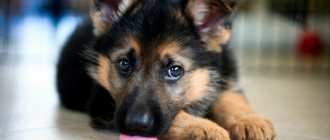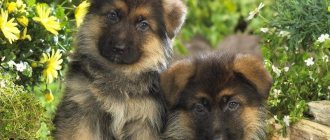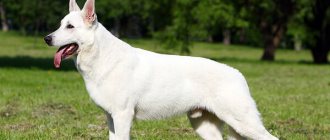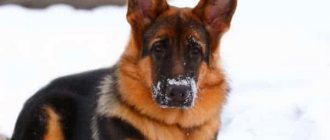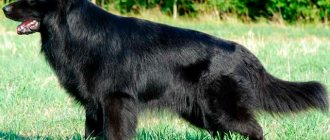The German Shepherd is one of the most common breeds in the world. This type of dog is strongly attached to its owner, adopting manners and emotions, becoming the best friend. The worst thing for a “German” is separation from his owner, even for a short period of time. The main characteristics of this large breed are courage, confidence and intelligence. An attractive and loyal animal can be not only a pet, but also a reliable guard and comrade in the service.
This is a strong and muscular, fast and energetic breed, endowed with good intuition and easy to train. Another advantage of the breed is its thick, beautiful coat, which can protect even from severe frosts . And although according to the standard the norm is black, black and red or black and tan, there are also motley dogs.
Read the article on the topic: “All shepherd dogs with names and photos - 60 species in alphabetical order.”
How do German Shepherds change color?
The color of the German Shepherd changes gradually. Most newborn puppies have dark coats that look about the same. During the molting period, it turns from smooth and soft to hard. If the puppy has a zonal type color, and the appearance of the additional color is pale brown, with age it acquires brightness and becomes red-red. A gray dog in childhood has the shade of a dirty rag. At four months the fur gradually falls out, by seven months the saddle cloth is already clearly outlined, and by one year the coat ends and the color no longer changes. During the molting period, puppies need to be looked after - combed using a comb or furminator.
Basic moments
- The White Swiss Shepherd is a strong, temperamental, hardy, very energetic dog with a strong nervous system.
- Outwardly, with the exception of color, it is similar to the German Shepherd, but, unlike that one, it is less reckless, excitable, and demonstrates aggression only in the case of an obvious threat.
- The dog is incredibly affectionate with all members of the household and extremely friendly towards children.
- The shepherd treats strangers with restraint, does not like familiarity towards itself, but will not show aggression.
- Lives in peace and harmony with other pets, including cats.
- The Swiss Shepherd is highly intelligent, quick-witted, and very easy to train.
- Easily socialized in human society - can cope with the functions of a guard, guide, rescuer, tracker guide, watchman. Representatives of this breed often serve in law enforcement agencies.
- Dogs love to lead an active lifestyle and need regular exercise and movement.
- They are distinguished by excellent health, and even at an advanced age they remain active.
- The best place for a White Swiss Shepherd to live is a country house, but its unpretentious character and ability to adapt to any conditions allow it to be kept in an urban environment.
Many dog lovers get white Swiss shepherds, being captivated by the spectacular, unusual appearance of these animals. Only over time do they discover their magnificent qualities inherent in serious service dogs. This beautiful, affectionate, good-natured dog, with an impressive texture, is unpretentious and hardy, easy-going and tireless in games. The love of White Swiss Shepherds for their owners is boundless; they need to know that loved ones are nearby, to feel family warmth and to feel needed.
Color of working shepherd dogs
To have a clearer idea of such a dog, take a look at the photo below of a zone-colored German Shepherd puppy. What does this color look like according to the RKF description?
The lower part of the coat is light. Slightly higher wool is sable-colored. The “saddle cloth” is followed by a yellow-brown tint. It alternates with gray color. And the finishing touch is black.
Black "Germans"
They are very rare and there are few of them. What can be seen at German Shepherd shows has nothing to do with the true black color. Why? Yes, because the representatives of the breed are black and brown. That is, visually their color appears black, but if you examine each hair of the fur, you will find a brown pigment.
A black German Shepherd should not have any impurities in the color of its coat.
Care
Whatever color your pet is, it will require care. If you decide to get a German Shepherd, be prepared to feed him quality foods that are high in protein. The basis of the diet should be meat. You can feed her with industrial food, but in this case you need to choose only premium food.
Fatty and floury, sweet and smoked foods should not be given, this is very harmful and can lead not only to obesity, but also to diseases of various internal organs. Portions should be adjusted based on weight and lifestyle; dogs that move a lot need more nutrients.
It is important to monitor the animals’ eyes, because these are weak points for them. If there is purulent discharge or inflammation, contact your veterinarian. Wipe them regularly with chlorhexidine or a strong infusion of tea.
Vaccinate your pet as necessary, give it anthelmintic drugs, and comb its hair. A shepherd dog may be allergic to a certain product or the type of dry food; this disease is similar to a skin disease, and in order to diagnose it, it is important to contact a veterinarian in time.
Do not forget about constant movement, which plays a big role in the proper development of the puppy and the preservation of youth as an adult representative of the breed. Active games promote healthy joints, spine and good mood.
About once a week, conduct a home inspection of your pet, clean its ears and eyes. If there are any deviations from the norm, contact the clinic. Of course, such dogs live best in a private home, and on the street. But they are able to live in an apartment, only then you need to walk with them for a very long time. They need physical activity, movement and communication with their owner. It is better if it takes place in the fresh air. In any case, you will have to talk to your pet very often, pet him, show him that he is important, and then he will be healthy and live a long, happy life.
Breeding lines
The incredible popularity of this extraordinary breed has led to the emergence of a large number of its subtypes in different countries, differing both in appearance and character traits.
Exhibition of West Germany (High Breeding Lines).
These dogs are closest to the standard. They are bred primarily for exhibitions.
Since the main attention during reproduction is paid to the exterior, and not to the development and preservation of working qualities, these animals have significant disadvantages - weak character and service qualities
Show dogs have a luxurious coat of predominantly saddle color with bright tan marks, but sometimes you can also find zone-colored specimens.
If we talk about ideals, then there are also opposites, for example, the dwarf German shepherd. You can read about it on our website.
The highly bred Sheepdog is good as a family member and friend, and can also be used to participate in sporting competitions. But, if you need a guard or a service dog, opt for another type of German shepherd (photos and names can be found in this article and on our website).
Working lines
These strong dogs (sometimes called service breeding), while less elegant than their show line counterparts, are much more similar to the very first representatives of the breed.
A working German Shepherd can come in a variety of coat types and colors. Zoned, black or black and tan - all colors of German shepherds are typical for these dogs; you can often find black and white colors.
The priority goal of breeding all working Europeans is service qualities.
German Shepherds of working breeding are instinctive in their behavior, they have a strong nervous system and a lot of energy. They are demanding of training and workload, aggressive, and temperamental. Working bred German Shepherd puppies are carefully selected for service and undergo multiple training courses. You can read more about German Shepherd puppies and pregnancy in our article.
Such dogs are most suitable for police, military, drug and explosive detection, they are excellent search and rescue dogs, and are also suitable for personal protection.
For a family living an active life, ready to devote attention and time to their pet, a working European will be an excellent companion, but do not expect calm, measured and phlegmatic behavior from her.
American line
American breeders focused on the appearance and speed of movement of dogs, leaving aside their working qualities. Shepherd dogs are taller, they have an elongated body with a narrow head, they have a somewhat angular shape. The saddle color (sometimes called suit) is common, but other standard colors are also found, as well as pure white.
American dogs are gentle in character, balanced and calm. They rarely show aggression and are highly trainable. However, there are such disadvantages of the breed as excessive emotionality and poor health and nervous system. These beauties will be good companions and loyal family members.
English line
In addition to the listed types, which are widespread, there are less popular varieties of German shepherds that arose as a result of mutation or selection. These are such subtypes as Panda, Czechoslovakian Wolfdog and Sarlouz Wulfhound, Kunming Shepherd and others.
Zone color
Puppies of the zone color, which is also called wolf color, are becoming less and less common today - some of the young dog breeders have never even seen a representative of the classic “wolf” color. However, it is generally accepted that it is the zonal coloring that is the original for representatives of the German breed - all other options are its derivatives.
The color zones in such dogs are distributed in rings - hairs with black tips, with a zone of black or brown shade, then again black and with a base of a light shade.
The zone-gray color is dominant in the German breed - if during mating one of the parents is gray in color, this will definitely show up. However, on the other hand, this gene does not exist in a recessive form, therefore it will not be possible to obtain it on the basis of zonal or black-and-white flowers. Consequently, if the producers of the zone-gray color disappear, it will be lost forever to posterity.
Advertising:
However, breeders who follow fashion trends and think more about financial interests than about the conservation of endangered species, rarely think about the consequences of underestimating the factors contributing to the disappearance of the “wolf” color. Therefore, it is worth talking about this more often and more in order to be able to avoid danger and correct the existing situation.
Behavior, temperament
Despite changing breed standards, modern German Shepherds have perfectly preserved the best potential of their ancestors. The complex of mental qualities clearly defined in the breed includes mental alertness and firmness, combativeness and obedience, devotion to the owner and sensitivity, complemented by balance. The speed of reaction determines the liveliness of the dog’s temperament and is formed by the genotype.
Other characteristic breed qualities can largely be created by man, including such an important factor as the obedience of the German Shepherd against the backdrop of its innate desire to listen to the leader. Shepherd dogs need to feel a sense of community with people, and developing this feeling is the direct task of the breeder using imprinting. All dogs that have not undergone imprinting are unsociable and extremely difficult to train.
German Shepherd puppies are inquisitive by nature, but the owner of a pet of this breed can develop this feeling in the dog during the process of education and socialization. Fighting and aggressiveness are qualities necessary for a service breed, but such important and genetically determined characteristics are difficult to correct, which must be taken into account when choosing a puppy.
Dimensions, weight and other distinctive features
The black-backed German Shepherd is a dog of above average height, with a height of 55 to 65 cm at the withers.
Weight
The main distinguishing feature of these dogs is the presence of a dark saddle-shaped spot covering the neck, shoulders, as well as the back and sides of the shepherd from the withers to the tail . The saddle cloth, or, as it is also called, the mantle, can be of various shapes and sizes.
It can also be either saturated, coal-black, or weakened - grayish or even brownish.
NOTE!
The main color, called tan, with black-and-white color comes in varying intensities: from light, yellowish, to very bright and rich, reddish-brown.
Most black-backed German Shepherds have more or less pronounced darkening on the face, often looking like a black mask.
The edging of the eyelids and lips are exclusively black.
Good pigmentation is mandatory for a dog of this color, since its absence indicates a weakened genotype in animals of this line.
Eye and skin color
According to accepted standards, the iris of representatives cannot be black; dark tones are allowed.
The shades of fur and eyes are not comparable; dark animals have light variants and vice versa. Important! Cynologists believe that if the color of the irises and coat are combined, then such individuals look more attractive than their counterparts.
In the presence of a colorless, blurry color, pets have a darkish rim around the eyes and small blackish spots on the tongue. The skin of individuals has a gray-blue tone, with pink under the tan. The nose is painted in deep dark undertones.
Color variations
All about black-backed German Shepherds
The black-backed German Shepherd is extremely popular among professional breeders. This noble and beautiful dog is a regular participant in many exhibitions. Purebred representatives of the breed have their own temperament, working qualities, and also require certain conditions of maintenance, so before getting such a pet you need to carefully study the rules of caring for it.
Black-haired German Shepherds appeared in Germany in the mid-19th century, bred by Max Frederick von Stephanitz. The progenitor of the breed is the male Greif; this dog had a dirty white coat color, he was distinguished by his stately posture and unusual intelligence. The only thing that did not suit the breeder was the color of the pet’s coat, which did not meet the breed standards.
A few years later, the breeder finally managed to get the noble color of the dog, and already in 1924 the first beauties were brought to Russia. At first, many problems arose with their breeding, since there were not enough skills and funds for maintenance, but over time, a kennel club opened in the country, and its representatives began to actively breed healthy pets.
Black Sheepdogs have an elongated body shape, but do not look squat. Their body is proportional, all parts are harmoniously combined with each other. The length of the head is 40% of the height at the withers. The skull and muzzle are equal in length. The head is of medium width and wedge-shaped, while in females it is less massive than in males.
The dog's ears are small, erect, triangular in shape and slightly rounded at the tips. The eyes of a black-backed shepherd dog are oval, dark, their gaze is alert and intelligent. The nose is black and quite large. The neck is characterized by well-developed muscles and is set at an angle of 45 degrees. Dogs of this species have especially pronounced withers, they are sloping and slightly elongated.
When animals are in an interested state, their tail rises, and in a calm state it is lowered. The dog's limbs are straight and strong, the hind legs are slightly longer than the front legs, they are muscular. As for wool, it can be either hard, short, or soft, elongated. The dog is of average height, its height ranges from 55 to 65 cm. The weight of individuals reaches from 22 to 40 kg.
The main distinguishing feature of these German Shepherds is the presence of dark spots on the fur, which resemble the shape of a saddle cloth. The spots are located on the back, shoulders, neck, withers and tail. They can be of various sizes and shapes, and can also be intensely or lightly colored.
The pet of this breed is an attentive, very intelligent and devoted pet to its owner. His character is characterized by distrust of strangers, determination and courage. Such dogs make excellent bodyguards and guards, since it is almost impossible to bribe and deceive them. Since a shepherd dog of this species, with proper upbringing, becomes obedient, it never attacks strangers without the owner’s command, but if he is not around, he can make decisions on his own. The Black Sheepdog is considered universal; it is usually bred as:
- companion dogs;
- a reliable security guard;
- service dog;
- guide
The main advantages of this breed include: fast learning, loyalty, a fairly high level of intelligence, protective instincts and good working qualities. As for the disadvantages, there are few of them: dogs constantly need physical activity and require systematic training.
These charming fluffy balls will not leave anyone indifferent. Puppies of this breed have large paws, an innocent look and look like clumsy bear cubs. It is best to purchase babies in specialized nurseries (military or private), which are engaged in professional breeding of purebred individuals. If you plan to prepare your pet for a show career, then immediately after acquisition he needs to be provided with proper upbringing and proper care.
Purebred babies, in addition to having a pedigree, must also have a certificate of suitability for breeding; the breed line should not contain representatives who suffer from genetic diseases and other deviations from the breed.
Before choosing a suitable puppy, you need to pay attention to the previous conditions of its maintenance, as well as the relationship with the mother dog. Usually up to 11 puppies are born in one litter. Preference should be given to those individuals who are distinguished by their appearance, good manners and fatness.
Healthy baby black-haired shepherd dogs move confidently and stand on their paws, are perfectly oriented in the surrounding space, have an intelligent look, and clean and shiny fur. They are active and inquisitive, and do not show cowardice or signs of aggression. The body of the puppies is elongated, but not square. The ears of small shepherd dogs under the age of 2-3 months droop, but if the tips of the shells are in a standing position, then this is a sign of ossification of cartilage caused by improper phosphorus-calcium metabolism. The tail of puppies is straight and unkinked.
Up to two months of age, puppies' eyes may have a blue tint, but this disappears over time. It is recommended to separate babies from their mother at an early age; this is best done when they are 2.5-3 months old. The older the dog, the more difficult it is to train it and wean it from bad habits.
Shepherd dogs of this species are distinguished by their unusual coat color. The black and tan color is dominant in relation to the black color gene, but it prevails over the black and tan shade. Sometimes in nature there are individuals whose saddle cloth is weakened; this is due to the loss of the intensity of the black color on the back. If, when breeding dogs, the descendants of black-backed parents are used without admixture of other genes, then the color becomes lighter over time.
The main feature in the color of these shepherd dogs is that the saddle cloth (“black mantle”) can smoothly descend to the paws of the animal. As for the lower part of the body, it can be:
- red;
- gray;
- yellow;
- light brown.
The muzzle of dogs has a “dark mask”; the color of the chest can vary from black to light. Often there is a black “tie” on the chest. The scoop of each individual may have a different pattern and shade.
Black-haired German Shepherds are characterized by a long life; if kept in good conditions, pets live up to 14 years. Despite the fact that individuals of this breed are distinguished by good health, they can sometimes be susceptible to such ailments as allergies, diseases of the gastrointestinal tract, and inflammatory processes in the ears. Dogs also suffer from skin diseases (dermatitis, eczema) and hip dysplasia.
In addition, pets of this breed are predisposed to gastric volvulus, so for their feeding it is necessary to create a strict schedule, try not to overfeed the pet and ensure that it is at rest for 3 hours after eating.
Before you bring a black-backed German Shepherd into your home, you need to know that it will shed heavily. Therefore, you should be prepared for the fact that your pet will have to be combed at least 4 times a week. In addition, the dog needs to be mentally and physically trained and walked in the fresh air. For those owners who spend most of their time at work and on weekends they just like to lie on the couch, this breed of dog is not suitable.
German Shepherds are not particularly demanding in terms of care, but their owners need to regularly monitor the condition of their pets' teeth and ears. It is recommended to thoroughly brush your teeth with a specially designed toothpaste; periodically, dogs should be allowed to chew on fresh bones. The ears are wiped with a damp swab twice a month.
To prevent the animal's claws from causing pain when running and jumping on hard surfaces, they need to be trimmed once a month.
Proper nutrition also plays a huge role in keeping such pets, so future owners need to be prepared to spend a lot on food. Since the breed is large, the individual requires up to 4 meals per day. Some dog breeders prefer to feed their pets dry food; in this case, you should purchase super-premium products.
It is worth noting that such dogs can also be fed natural products in the form of vegetables, meat scraps, eggs and cottage cheese.
Black Sheepdogs are considered smart animals, so it is recommended to start training them from a very early age. Dogs of this breed are able to learn simple commands in just a few repetitions. It is best to conduct training in a playful way, this will interest the pet. You cannot show aggression during training, as the dog will misunderstand it and contact with the pet will be lost forever.
First of all, the puppy must learn its name well and get used to it. To do this, you should stroke his head and affectionately call his pet's name. With older puppies, you can begin to teach commands such as “Give me a paw”, “Sit”, “Voice”, “Come to me”, “Lie down”. If the child does not follow commands, you cannot punish for this. The pet must also clearly know the place that is allocated for it.
The commands “No” and “Fu” are also mandatory for training. It is also important to wean the puppy from picking up from the ground. When the future shepherd dog turns 6 months old, she is accustomed to an accessory such as a muzzle.
For good behavior, your pet should be rewarded with various treats. Also, the dog should be taught to be wary of strangers; for this purpose, guests should not be allowed to play with it.
For interesting facts about German Shepherds, watch the following video.
Character of dogs
The black-haired German Shepherd is an intelligent, vigilant, attentive and very loyal dog to its owners. She is distinguished by courage, determination and distrust of strangers.
This is a reliable guard and bodyguard who cannot be deceived or bribed.
Impeccably obedient when properly trained, the shepherd will wait for the owner's command before pouncing on a stranger who seems suspicious to her.
At the same time, these dogs are quite capable of making their own decisions if the owner is not nearby.
At home, shepherd dogs are quite friendly: they treat all family members well, although they tend to consider only one person as the main owner.
The show-bred Black Sheepdog, in addition, has an innate ability to show itself in the best light during exhibition.
But in order for a pet to take first place, it must be taught from an early age the correct exhibition stance and walking in a straight line and in a circle.
Non-standard suits of the “Germans”
The following colors of German Shepherds are rare. All of them are considered marriage. Such dogs are not allowed for exhibitions or breeding. But if you need an unusual pet-class puppy, then there are no barriers to getting a four-legged friend with a unique coat color. It does not affect the health or character of the pet in any way.
Let's look at the rarest colors of "Germans" with photographs and brief descriptions.
White
Light-colored puppies appear if both parents display the recessive gene responsible for this color.
Individuals with a white color are not albinos. They have a black nose, dark eyes and claws. But they are rejected.
Red (yellow)
Another non-standard look. Red dogs look impressive. However, this is a deviation that is not recognized by kennel clubs. At the same time, red tan or zone-red color is allowed.
Grey
It is also called blue. It appears as a result of a weakening of the black color. Dogs of this type are culled.
Golden
A variety of non-standard red color. Occurs when a certain pigment is present. The coat of these “Germans” is light, almost golden in color.
Spotted
The fur coat of spotted German Shepherds seems to be covered with multiple pigment spots. They are found throughout the body and are scattered unevenly in different areas. As a rule, such dogs are mestizos of shepherds and mongrel dogs.
Roan
Sometimes, with age, a “German” can turn gray. More and more light hairs and fewer and fewer dark ones will appear on the fur coat. When gray hair begins to predominate, we can talk about a roan color.
No matter how much you would like to get a German Shepherd of an unusual color, it is worth remembering that such an animal is not recognized as a standard. It can only be kept as a pet.
If you plan to participate in exhibitions or breed, you must take a “German” of an acceptable color. Moreover, there is enough diversity even among standard types.
Coat types
When talking about the colors of a German Shepherd, one cannot fail to mention the types of its coat.
Representatives of the breed are smooth-haired or standard. And they are long-haired. The latter are found among show line dogs. “Long ones” resemble teddy bears. As a rule, they only have problems with their psyche.
Long-haired Shepherds can be overly cowardly or aggressive. The first ones hide their cowardice behind passive defensive reactions of behavior. That is, such a dog can bark threateningly and pretend that he is about to bite. But as soon as you swing at him, the dog tucks its tail and crouches to the ground. This looks especially terrible at a monobreed show, when the animal undergoes a mutated test. In other words, it is bitten off on the sleeve.
The latter have irrepressible aggression. It is very difficult in the city with such a pet. He tries to taste everything that moves. And this should under no circumstances be allowed. If such a dog once feels superior to a person, there is a high probability of losing control over it. The pet may stop obeying its owner.
Tags
Black-and-white color in Black-and-white color Uzonary color New color of quick-black color. Black-and-white color. so that a shepherd dog can be a real shepherd. A shepherd dog must have a saddle coat. Black-colored ancestors of black-haired shepherds.shepherds of black-haired color.shepherds of black-colored color.time black-haired color Dogs Dog breeds Dogs zonal color Zoner same ZONARY color.essence. Zonal ones are colored by zonal ones. Zoned color why zoned puppies
answeringcatscats
